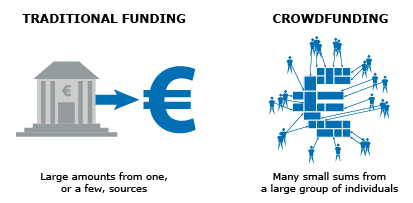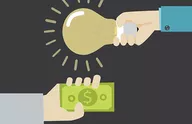
Crowdfunding is a modern method that has become popular among entrepreneurs, small business owners, and startups in recent years. It funds a project or business venture by raising money from many people, usually through the Internet or an online fundraising platform. This article will discuss crowdfunding in detail, including its history, benefits, types, and how it works. Our goal is to provide comprehensive and informative content to help you understand crowdfunding better and make informed decisions when using it as a financing method.
History of Crowdfunding
Crowdfunding has been around for centuries, but it gained popularity in the 21st century with the advent of the Internet. The first ever crowdfunding site and platform was launched in 2003, but it wasn’t until 2009 that it gained widespread attention and monetary support. Kickstarter, one of the most popular and top crowdfunding sites and platforms, was launched in 2009 and has since raised over $5 billion for various creative projects alone.
Benefits of Crowdfunding
Access to a large pool of investors:
Crowdfunding allows entrepreneurs to access a large pool of potential investors interested in their idea or project. This can provide the capital to launch and bring the project to market.
Market validation:
Entrepreneurs can use a crowdfunding platform to test their idea to gauge market interest and demand for their products or service. This can help them make informed decisions about developing and marketing the product.
Building a community of supporters:
Crowdfunding can help entrepreneurs build a community of supporters and small investors invested in the project’s success. In addition, these backers can provide valuable feedback, referrals, and testimonials that can help attract new customers and investors.
Cost-effective: Crowdfunding is often more cost-effective than traditional financing methods, such as bank loans or using venture capital firms. This is because crowdfunding platforms charge lower fees, and entrepreneurs do not have to give up company equity.

Drawbacks of Crowdfunding
- Competition: Crowdfunding platforms are highly competitive, and it can be challenging to stand out from the crowd and attract backers. This is especially true for popular niches like technology or consumer products.
- Time-consuming: Crowdfunding campaigns can be time-consuming and require significant effort to plan, promote, and manage. This can challenge entrepreneurs who are already busy developing their products or service.
- Risk of failure: Crowdfunding campaigns are not guaranteed to succeed, and there is a risk that the entrepreneur will not meet their funding goal. This can be a setback for the project and may require the entrepreneur to seek alternative funding sources.
- Limited control: Crowdfunding platforms have rules and regulations that may limit the entrepreneur’s control over their campaign. For example, some platforms may restrict the types of rewards or incentives that can be offered to backers.
Crowdfunding can be a powerful tool for entrepreneurs looking to raise capital, test their ideas, obtain funding, and build a community of supporters. By understanding the benefits and drawbacks of various crowdfunding sites, entrepreneurs can decide whether crowdfunding is the proper financing method for their projects.
Types of Crowdfunding
There are four main types of crowdfunding: donation-based, donation crowdfunding only, reward-based platform amount-based, tips-based crowdfunding, equity-based, and debt-based.
Donation-based crowdfunding involves raising funds from many people without expecting a return on money presented themselves. It is usually used to further fundraising goals and raise money for charitable causes, social projects, or community development initiatives.
Reward-based crowdfunding involves offering rewards or incentives to backers in exchange for their support of creative work or projects. These rewards can range from small donations or tokens of appreciation to exclusive access to the product or service being developed.
Equity-based crowdfunding involves raising funds through crowdfunding websites in exchange for equity in the company. Startups and early-stage businesses usually use this crowdfunding type without accredited investors seeking funding to grow and expand small businesses and early-stage companies.
Debt-based crowdfunding involves raising funds through loans that are paid back with interest. This crowdfunding type of fixed funding is usually used by businesses and nonprofit organizations that need short-term financing for a specific project.

Each type of crowdfunding has its benefits and drawbacks.
For example, reward-based crowdfunding can be a great way to test market demand for a new product or service, but it requires a strong marketing and promotion strategy to attract backers.
Equity-based crowdfunding can provide the necessary capital to grow a company, but entrepreneurs must be willing to give up equity in their company.
Debt-based crowdfunding can provide access to funding without giving up equity, but it requires a strong credit history and financial standing.
Donation-based and popular crowdfunding platforms can be a powerful way to raise awareness and raise funds for a social cause, but they may not be sustainable long-term funding sources.
How Crowdfunding Works
The crowdfunding process typically involves setting up a campaign on a crowdfunding platform, outlining the project’s details, and setting a funding goal. The campaign is then promoted through social media, email, and other marketing channels to spread awareness and attract backers. Once the funding goal is reached, all the money pledged, and funds raised are transferred to the entrepreneur or startup, and the project can begin.

How to Launch a Successful Crowdfunding Campaign
Launching a successful online crowdfunding fundraising campaign requires careful planning and execution. Here are some tips for launching a successful crowdfunding campaign:
Set a Realistic Funding Goal
Set the crowdfunding goal with a funding goal that is realistic and achievable with flexible funding throughout. This will make more money to help attract more investors and increase the business capital’s chances of meeting the funding goal.
Create a Compelling Pitch
Create a compelling pitch explaining the project, new business, venture, and value proposition. Use images and videos to help illustrate the project and make it more engaging.
Offer Attractive Rewards
Offer attractive and relevant rewards to the crowdfunding project and fundraising goal. This will help incentivize investors and increase the likelihood of other, most successful campaigns and crowdfunding projects meeting the funding goal.
Promote the Campaign
Promote the first crowdfunding site and campaign through social media, email marketing, website, and other channels. This will help increase the visibility of the first crowdfunding campaign project and attract more investors.

Conclusion
In conclusion, crowdfunding is a powerful financing method that provides instant access to a large pool of investors, helps entrepreneurs test their ideas, and can build a community of supporters. There are four main types of crowdfunding: donation-based, reward-based, equity-based, equity-based fundraising, and debt-based, each with unique benefits and drawbacks. By understanding the different kinds of crowdfunding offers and how it works, entrepreneurs can make informed decisions about using it as a financing method for raising capital for their projects.
CoopBusiness is a revolutionary cooperative business-building platform that empowers individuals to become entrepreneurs, business owners, and financially independent.
As a member, you’ll receive top-level business mentorship, access to our proprietary business systems, and the opportunity to access the funds you want to turn your business ideas into reality.